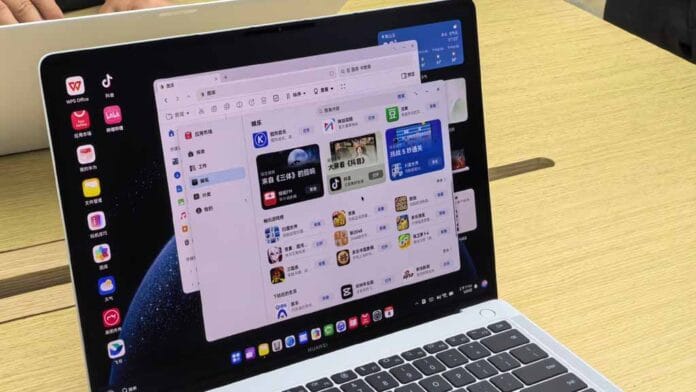Huawei has officially unveiled HarmonyOS PC, marking a significant milestone in its journey toward technological self-reliance.
This new operating system, also known as Hongmeng Computer in China, is designed to offer a seamless, secure, and AI-enhanced computing experience, positioning itself as a formidable alternative to Microsoft’s Windows and Apple’s macOS.
What Is HarmonyOS PC?
HarmonyOS PC is Huawei’s first fully self-developed desktop operating system, built from the ground up over five years with contributions from over 10,000 engineers and more than 2,700 patents .
It extends the HarmonyOS ecosystem—which already includes smartphones, tablets, smartwatches, and smart TVs—into the realm of personal computing.
The OS is constructed on the HarmonyOS 5 platform, featuring a proprietary Harmony kernel, the Ark graphics engine, the StarShield security architecture, and Huawei’s own development tools like ArkTS and ArkUI .
This architecture ensures tight integration between hardware and software, optimizing performance and security.
Key Features of HarmonyOS PC
1. Seamless Multi-Device Collaboration
HarmonyOS PC emphasizes distributed computing, allowing users to effortlessly share keyboards, mice, screens, and files across Huawei devices. This is facilitated by Huawei’s distributed soft bus technology, enabling real-time app handoff and synchronized operations between devices .
2. Enhanced Security and Privacy
Security is a cornerstone of HarmonyOS PC. The StarShield architecture provides chip-level full-disk encryption, ensuring data remains secure even if the hard drive is removed.
Additional features include real-name developer authentication, app store signature verification, and strict permissions for screen recording and screenshots.
A super privacy mode further enhances user privacy by disabling the camera, microphone, and location access system-wide .
3. AI-Driven User Experience
HarmonyOS PC integrates Huawei’s AI assistant, Xiaoyi, which supports voice interaction, smart summarization, translation, and contextual data search through AI-driven semantic understanding.
This AI integration aims to enhance productivity and provide a more intuitive user experience .
4. Modern and Intuitive User Interface
The user interface of HarmonyOS PC draws inspiration from macOS, featuring a bottom-center dock for apps, top status bars, and a clean, card-based desktop layout.
Dynamic wallpapers, motion effects, and layered window transitions contribute to a polished and modern aesthetic .
Huawei’s HarmonyOS Features
Huawei’s HarmonyOS has evolved into a comprehensive operating system, offering a wide array of features across its PC, mobile, and IoT platforms.
Below is a detailed overview of its key functionalities:
🔧 Core Architecture & Performance
- Microkernel Architecture: HarmonyOS employs a microkernel design, enhancing security and stability by isolating core services and reducing the system’s attack surface.
- Ark Engine: The Ark graphics engine delivers smooth animations, dynamic effects, and efficient multitasking, contributing to an enhanced user experience.
- Deterministic Latency Engine: This feature optimizes task scheduling, reducing response latency by approximately 25.7%, ensuring smoother app performance.
🤖 AI Integration
- Celia & Xiaoyi AI Assistants: These assistants offer functionalities such as real-time meeting summaries, document organization, language translation, and contextual data searches, enhancing productivity and user convenience.
- Drag-and-Drop AI Features: Users can drag files or images onto the AI assistant to receive instant summaries, translations, or related content suggestions, streamlining workflows.
🖥️ User Interface & Experience
- Modern UI Design: HarmonyOS features a clean, card-based desktop layout with dynamic wallpapers and motion effects, providing a visually appealing interface.
- Live Windows: Similar to Apple’s Dynamic Island, this feature displays real-time updates (e.g., delivery tracking, fitness stats) directly on the screen without opening the respective app.
- Knuckle Gestures: Users can perform quick actions, like capturing screenshots or extracting information, by drawing specific patterns with their knuckles on the screen.
🔒 Security & Privacy
- StarShield Security Architecture: Provides chip-level full-disk encryption, ensuring data remains secure even if the device is compromised.
- Super Privacy Mode: Allows users to disable the camera, microphone, and location access system-wide, enhancing privacy.
- App Permission Controls: HarmonyOS offers granular control over app permissions, preventing unauthorized access to sensitive information.
🔗 Ecosystem & Device Integration
- Super Device: Enables seamless collaboration between Huawei devices, allowing users to share screens, files, and control devices across the ecosystem effortlessly.
- Task Center: Allows applications to run across different devices without the need for separate installations, facilitating a cohesive multi-device experience.
- Huawei Share: Facilitates fast and secure file transfers between Huawei smartphones, tablets, and PCs without requiring a data cable.
🧠 Smart Features
- Smart Notification Center: Organizes notifications based on priority, ensuring users receive important alerts promptly.
- Service Widgets: Interactive widgets provide quick access to app functionalities directly from the home screen, enhancing user convenience.
- Smart Home Integration: HarmonyOS allows users to control smart home devices seamlessly, offering functionalities like recipe suggestions when connected to compatible appliances.
📱 Application Ecosystem
- AppGallery: Huawei’s official app store offers a growing selection of applications optimized for HarmonyOS, including over 150 native PC apps and more than 2,000 universal apps.
- Quick Apps: Lightweight applications that run without installation, providing users with instant access to services while conserving device resources.
HarmonyOS presents a robust and versatile operating system, integrating advanced AI capabilities, a modern user interface, stringent security measures, and seamless device interoperability.
Its comprehensive feature set positions it as a compelling alternative in the current OS landscape.
Strategic Implications
The launch of HarmonyOS PC is a strategic move by Huawei to reduce dependence on foreign technologies, particularly in light of escalating US-China tech tensions.
By developing a fully autonomous operating system, Huawei aims to bolster China’s technological self-sufficiency and provide a secure alternative for critical sectors such as government, finance, and national defense .
Availability
HarmonyOS PC is set to debut on May 19, 2025, powering Huawei’s new line of personal computers equipped with the Kirin X90 desktop chip.
While the OS is tailored for Huawei’s hardware ecosystem, it represents a significant step toward diversifying the global operating system landscape.
Final Thoughts
HarmonyOS PC embodies Huawei’s vision of a secure, intelligent, and interconnected computing environment.
Its emphasis on seamless device integration, robust security, and AI-enhanced user experience positions it as a compelling alternative to existing operating systems, particularly within Huawei’s ecosystem

